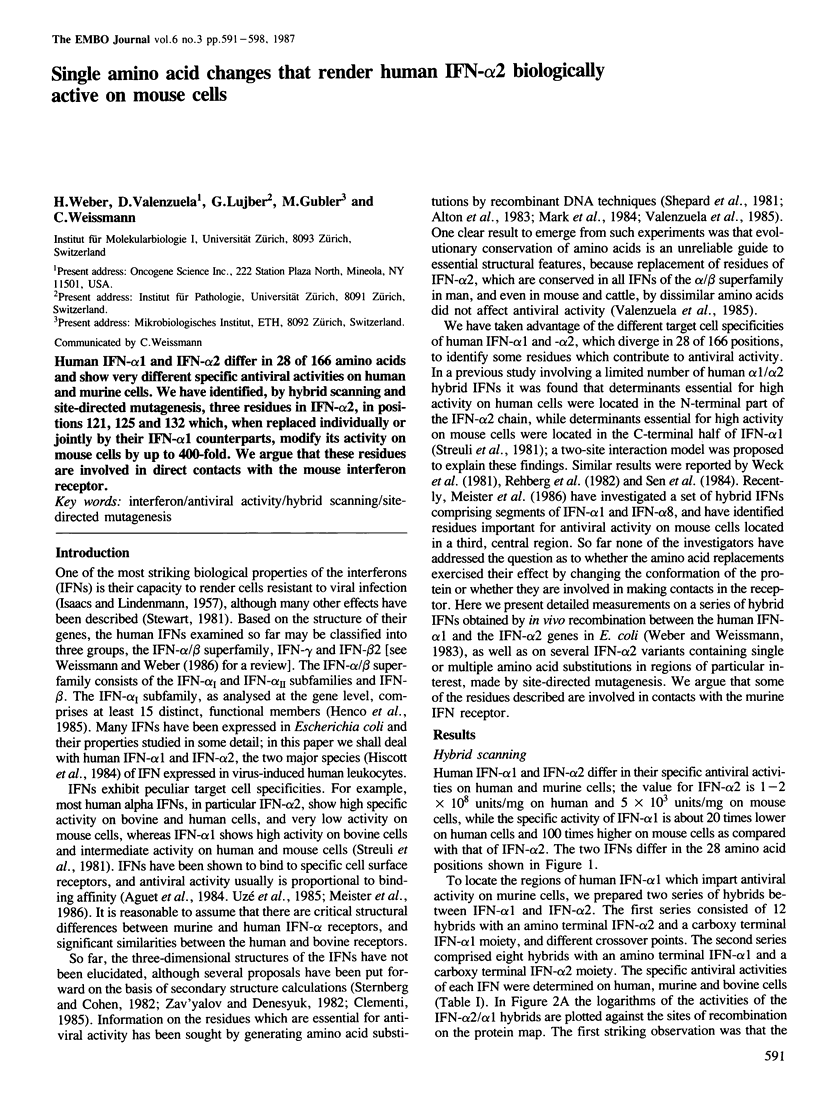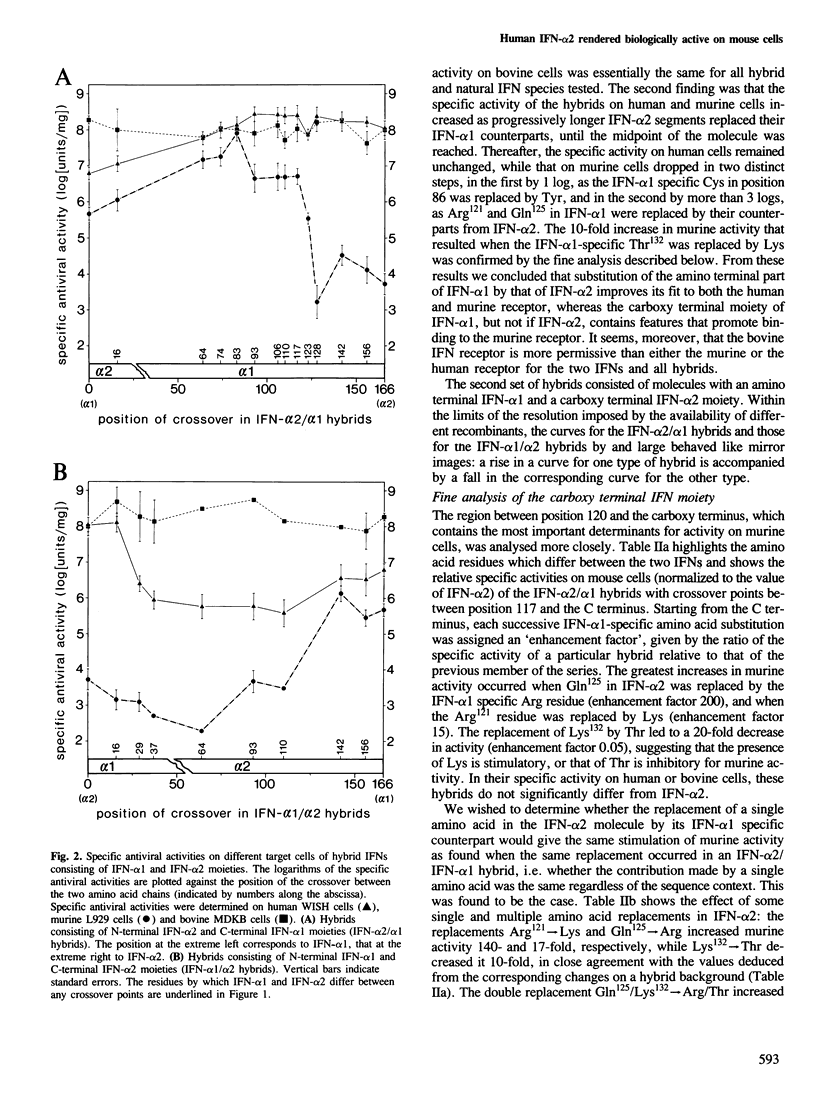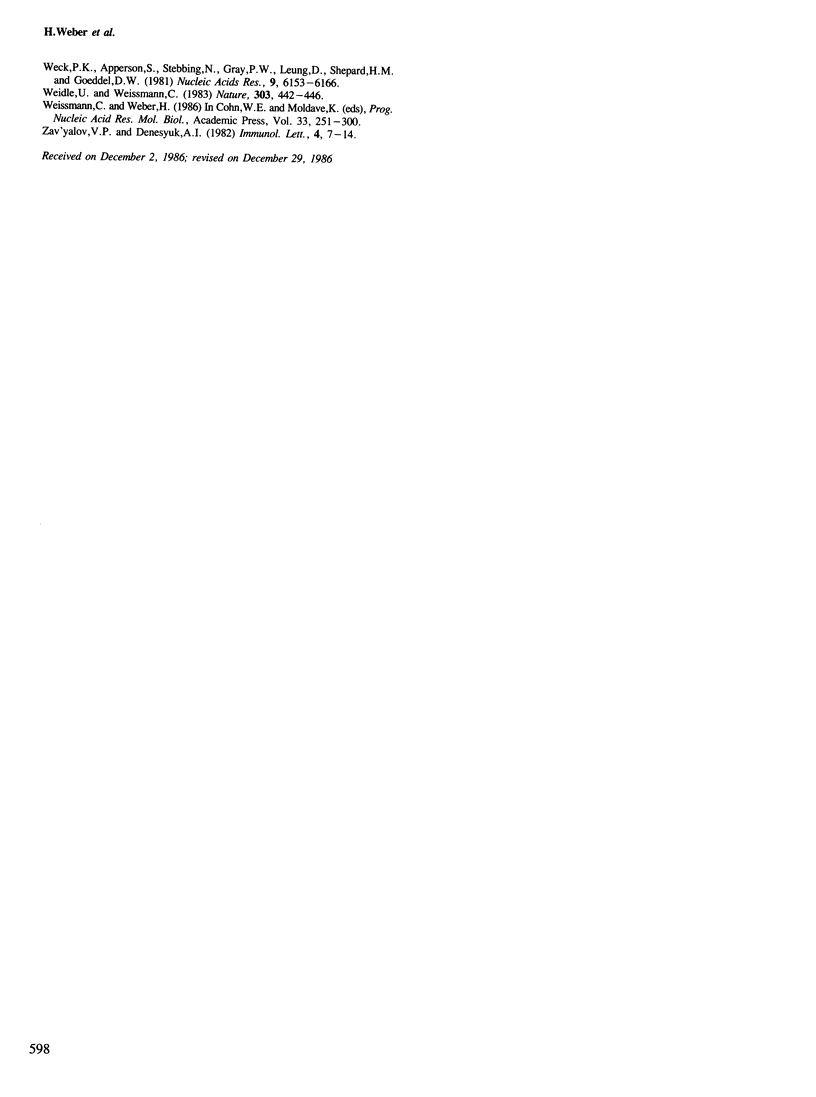Abstract
Human IFN-alpha 1 and IFN-alpha 2 differ in 28 of 166 amino acids and show very different specific antiviral activities on human and murine cells. We have identified, by hybrid scanning and site-directed mutagenesis, three residues in IFN-alpha 2, in positions 121, 125 and 132 which, when replaced individually or jointly by their IFN-alpha 1 counterparts, modify its activity on mouse cells by up to 400-fold. We argue that these residues are involved in direct contacts with the mouse interferon receptor.
Full text
PDF







Images in this article
Selected References
These references are in PubMed. This may not be the complete list of references from this article.
- Aguet M., Gröbke M., Dreiding P. Various human interferon alpha subclasses cross-react with common receptors: their binding affinities correlate with their specific biological activities. Virology. 1984 Jan 15;132(1):211–216. doi: 10.1016/0042-6822(84)90105-3. [DOI] [PubMed] [Google Scholar]
- Aguet M., Mogensen K. E. Interferon receptors. Interferon. 1983;5:1–22. [PubMed] [Google Scholar]
- Hayes T. G. Chou-Fasman analysis of the secondary structure of F and Le interferons. Biochem Biophys Res Commun. 1980 Jul 31;95(2):872–879. doi: 10.1016/0006-291x(80)90868-2. [DOI] [PubMed] [Google Scholar]
- Henco K., Brosius J., Fujisawa A., Fujisawa J. I., Haynes J. R., Hochstadt J., Kovacic T., Pasek M., Schamböck A., Schmid J. Structural relationship of human interferon alpha genes and pseudogenes. J Mol Biol. 1985 Sep 20;185(2):227–260. doi: 10.1016/0022-2836(85)90401-2. [DOI] [PubMed] [Google Scholar]
- Hiscott J., Cantell K., Weissmann C. Differential expression of human interferon genes. Nucleic Acids Res. 1984 May 11;12(9):3727–3746. doi: 10.1093/nar/12.9.3727. [DOI] [PMC free article] [PubMed] [Google Scholar]
- ISAACS A., LINDENMANN J. Virus interference. I. The interferon. Proc R Soc Lond B Biol Sci. 1957 Sep 12;147(927):258–267. doi: 10.1098/rspb.1957.0048. [DOI] [PubMed] [Google Scholar]
- Mark D. F., Lu S. D., Creasey A. A., Yamamoto R., Lin L. S. Site-specific mutagenesis of the human fibroblast interferon gene. Proc Natl Acad Sci U S A. 1984 Sep;81(18):5662–5666. doi: 10.1073/pnas.81.18.5662. [DOI] [PMC free article] [PubMed] [Google Scholar]
- Meister A., Uzé G., Mogensen K. E., Gresser I., Tovey M. G., Grütter M., Meyer F. Biological activities and receptor binding of two human recombinant interferons and their hybrids. J Gen Virol. 1986 Aug;67(Pt 8):1633–1643. doi: 10.1099/0022-1317-67-8-1633. [DOI] [PubMed] [Google Scholar]
- Rehberg E., Kelder B., Hoal E. G., Pestka S. Specific molecular activities of recombinant and hybrid leukocyte interferons. J Biol Chem. 1982 Oct 10;257(19):11497–11502. [PubMed] [Google Scholar]
- Remaut E., Tsao H., Fiers W. Improved plasmid vectors with a thermoinducible expression and temperature-regulated runaway replication. Gene. 1983 Apr;22(1):103–113. doi: 10.1016/0378-1119(83)90069-0. [DOI] [PubMed] [Google Scholar]
- Sen G. C., Herz R., Davatelis V., Pestka S. Antiviral and protein-inducing activities of recombinant human leukocyte interferons and their hybrids. J Virol. 1984 May;50(2):445–450. doi: 10.1128/jvi.50.2.445-450.1984. [DOI] [PMC free article] [PubMed] [Google Scholar]
- Shepard H. M., Leung D., Stebbing N., Goeddel D. V. A single amino acid change in IFN-beta1 abolishes its antiviral activity. Nature. 1981 Dec 10;294(5841):563–565. doi: 10.1038/294563a0. [DOI] [PubMed] [Google Scholar]
- Streuli M., Hall A., Boll W., Stewart W. E., 2nd, Nagata S., Weissmann C. Target cell specificity of two species of human interferon-alpha produced in Escherichia coli and of hybrid molecules derived from them. Proc Natl Acad Sci U S A. 1981 May;78(5):2848–2852. doi: 10.1073/pnas.78.5.2848. [DOI] [PMC free article] [PubMed] [Google Scholar]
- Uzé G., Mogensen K. E., Aguet M. Receptor dynamics of closely related ligands: "fast' and "slow' interferons. EMBO J. 1985 Jan;4(1):65–70. doi: 10.1002/j.1460-2075.1985.tb02318.x. [DOI] [PMC free article] [PubMed] [Google Scholar]
- Valenzuela D., Weber H., Weissmann C. Is sequence conservation in interferons due to selection for functional proteins? Nature. 1985 Feb 21;313(6004):698–700. doi: 10.1038/313698a0. [DOI] [PubMed] [Google Scholar]
- Weber H., Weissmann C. Formation of genes coding for hybrid proteins by recombination between related, cloned genes in E. coli. Nucleic Acids Res. 1983 Aug 25;11(16):5661–5669. doi: 10.1093/nar/11.16.5661. [DOI] [PMC free article] [PubMed] [Google Scholar]
- Weck P. K., Apperson S., Stebbing N., Gray P. W., Leung D., Shepard H. M., Goeddel D. V. Antiviral activities of hybrids of two major human leukocyte interferons. Nucleic Acids Res. 1981 Nov 25;9(22):6153–6166. doi: 10.1093/nar/9.22.6153. [DOI] [PMC free article] [PubMed] [Google Scholar]
- Weidle U., Weissmann C. The 5'-flanking region of a human IFN-alpha gene mediates viral induction of transcription. Nature. 1983 Jun 2;303(5916):442–446. doi: 10.1038/303442a0. [DOI] [PubMed] [Google Scholar]
- Weissmann C., Weber H. The interferon genes. Prog Nucleic Acid Res Mol Biol. 1986;33:251–300. doi: 10.1016/s0079-6603(08)60026-4. [DOI] [PubMed] [Google Scholar]
- Zav'yalov V. P., Denesyuk A. I. Possible conformation of interferons: a prediction based on amino acid composition and sequence. Immunol Lett. 1982 Jan;4(1):7–14. doi: 10.1016/0165-2478(82)90070-0. [DOI] [PubMed] [Google Scholar]



